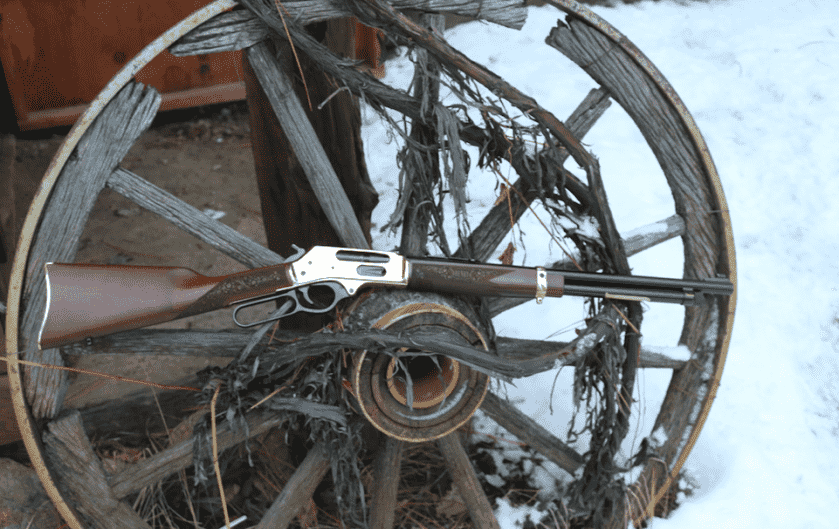
The Henry 45-70
While I normally cover the tactical and CCW guns, I do have one other group I always snatch up if the opportunity presents itself. I guess you could call them 1866 tactical guns, and be correct. I’m talking about lever actions of course, including this week’s Henry in 45-70.
From a practical standpoint, I find that lever actions still have a place. They are so well balanced and handle so quickly, it would surprise you if you grew up on an AR. I didn’t shoot one more than a handful of times until I was already full-grown, and a soldier to boot. But I still came away impressed. With some practice, they also provide a remarkable rate of fire.
If you unable to use a magazine fed semi-automatic rifle where you live, you have to think about effective alternatives. This whopper of a lever gun would absolutely be my choice of a defensive tool. It also has the advantage of not looking particularly scary to the neighbors, though it should. These are the guns that won the West. They are also an excellent choice for hunting, offering a viable alternative to bolt actions in several regions. They will throw a monstrous bullet if need be, as illustrated by our 45-70 model this week.

But practicality aside, I tend to like lever actions for altogether different reasons. For me, and I’m sure many of you, they inspire a nostalgia I don’t get from anything else. You physically can’t pick one up without thinking about Rio Bravo. No matter how old I get, a handy lever blaster makes me feel like a kid again. And that alone is worth the price of admission.

Henry is by far the leader in lever-action rifles today, if not in volume then certainly in quality. The company’s motto is one I can absolutely get behind. Made in America. Or not made at all. This is of particular importance in this type of firearm, besides supporting the economy of the home team. A great many “Cowboy Guns” of new manufacture are cheap overseas junk. No disrespect to foreign guns, I own many. But there is a massive difference between “German Engineering” and “Paki pot metal firing pin.” Sadly, as popularity has declined, many guns in this category are made to be looked at.
Henry, however, doesn’t play like that. These guns come with a lifetime warranty, and they are meant to be used. While they also make a few single shots and the AR-7, the lever-action is a way of life for them. The guns might be beautiful, but they aren’t supposed to be safe queens. This company wants you to not just own the guns, but shoot them.
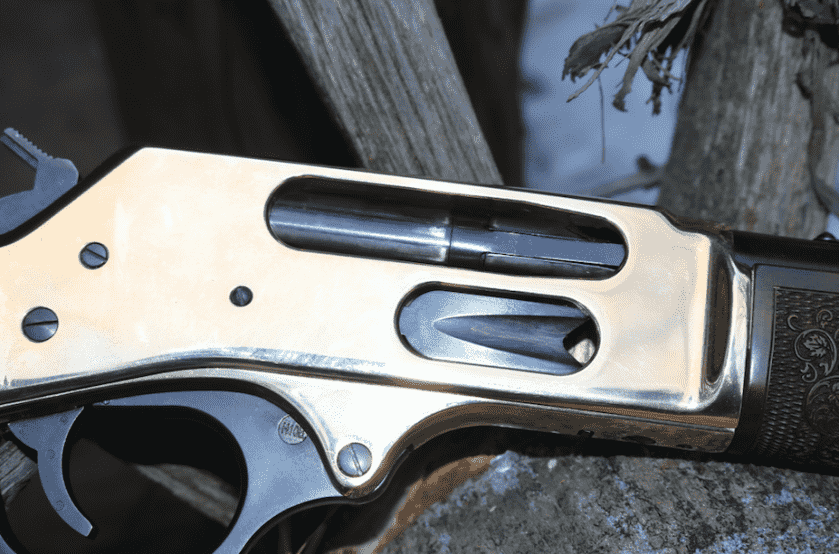
And the 45-70 in for review reflects that. While in the past Henry has stayed true to the original tubular magazine loading system, this year they switched it up. By customer request, they now offer side loading gate models. I’m not a lever gun purist, so I like this change a lot. It means when I’m pretending to be John Wayne, I can load like John Wayne.

The rifle itself is a beauty, with well thought out checkering on the wood furniture. Not only does it look good, but it offers just the right amount of grip for less than ideal field conditions. Something I did not know prior to this review, the receiver is actually brass to match the butt pad. Not brass over steel. Just brass, tempered in a proprietary hardening process. This gives it the same strength as steel, with a deep touch of class.
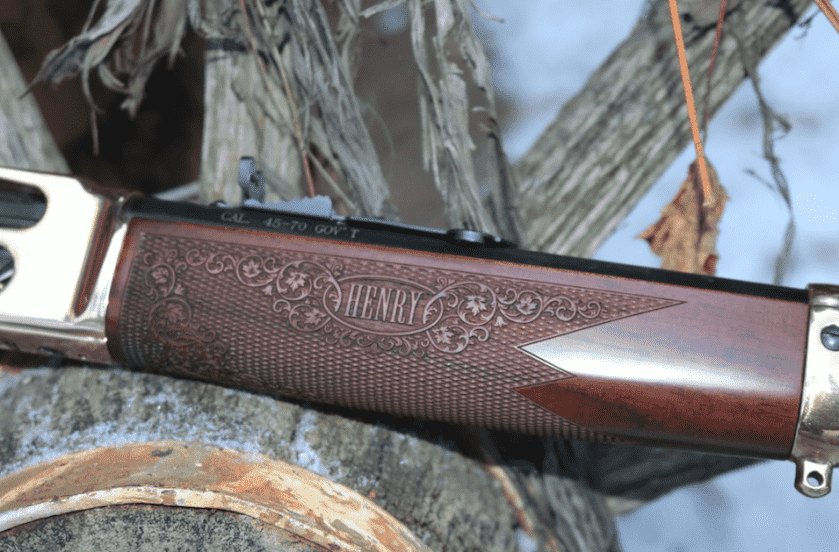
The sights are a semi-buckhorn rear, adjustable for elevation and windage, with an ivory bead front. The 20-inch barrel offers an excellent mix of capacity and handling, holding 4 in the tubular magazine in this caliber.
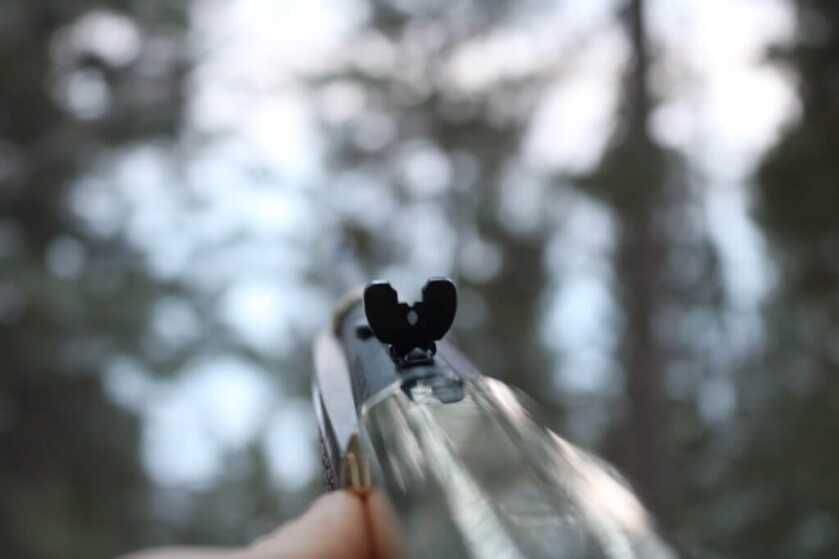
The action is smooth, right from day one. No break-in required here, though I’m sure it actually improves with time. The trigger is crisp and clean, with a break weight on par with most bolt actions. The new load gate system works well and is sure to be a hit. The one reminder you aren’t in the Old West is the orange follower in the tube, to show with certainty when it is empty. But I find that a happy bit of modern, so no harm no foul.

When it comes to rifle caliber lever actions, I only turn to one place to feed it. Hornady Ammunition, of course, with the famous LEVERevolution. First introduced in 2006, LEVERevolution gave the older rifle rounds a new lease on life.
The only problem with lever-action rifles, from a ballistic standpoint, was the tubular magazine. Due to the rounds stacking one in front of the other (like a shotgun), you couldn’t use pointed bullets. You might get away with a pointy nose bullet resting on the primer of the round in front of it for a while, but it’s generally a bad idea. Therefore, lever specific calibers always before had rounded or flat-nosed bullets.
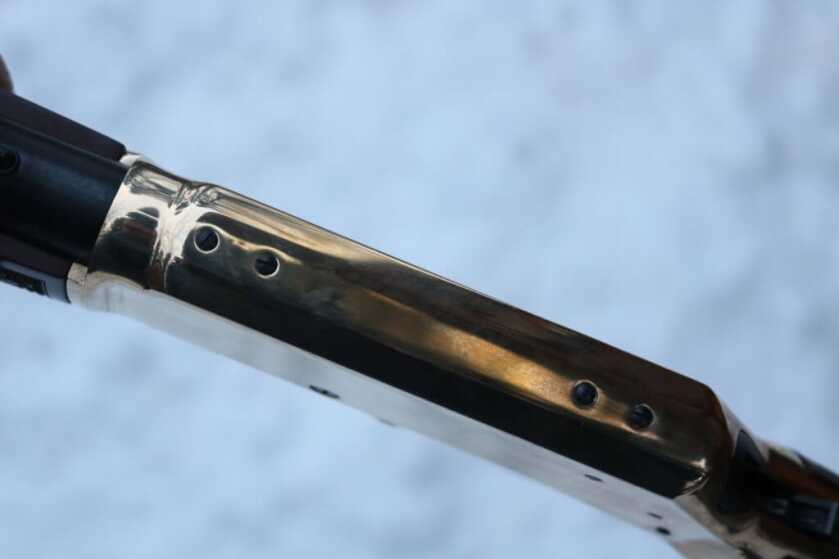
Flat-nosed bullets are fine across the room but don’t fly quite as well at range. 3rd-grade aerodynamics is pretty hard to miss with that one. Hornady, however, solved this problem with gusto. The LEVERevolution line features a soft flexible tip. It negates the problem of setting off primers in the tube but still has enough rigidity to make the bullet fly like a modern rifle bullet.
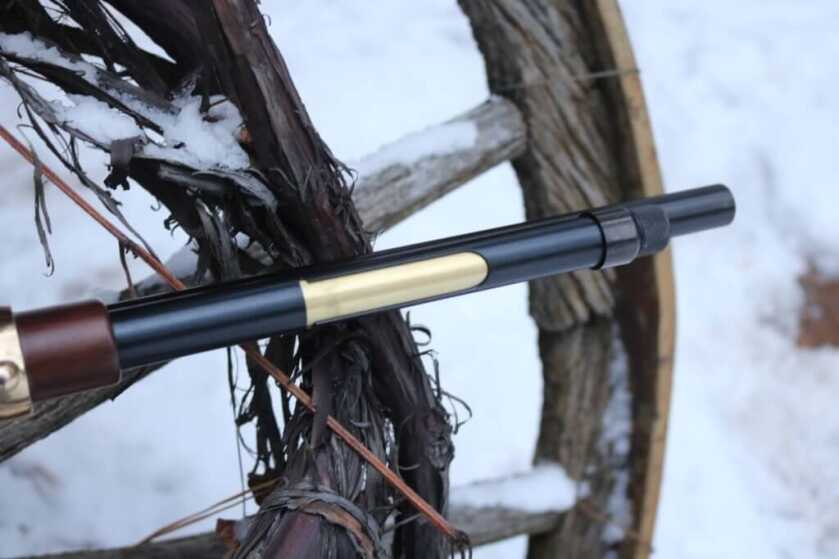
For testing, Hornady sent both the 325-grain FTX and 250-grain Monoflex. 325 grains moving at over 2000 fps is nothing to sneeze at. We first set out to do some accuracy testing, which is about the only thing sketchy in our review. I am always going to do an accuracy test. But I also know enough about myself to tell you that the group I can shoot with irons, is not the mechanical absolute of the rifle.
To get the best group possible, I did set conditions up in my favor. I shot off my Eberlestock backpack, with new attached rifle rest. Also, Hornady is my gold standard for accuracy, especially in lever gun calibers. But still, it isn’t exactly like using bipods and a 30 power scope. The Henry turned in just over 2 MOA average, which is, in my opinion, is plenty for hunting or defense. And I’m also sure that it would do better if you happen to practice all the time with these type of iron sights.
On a more fun front, we blasted a pile of 45-70 at some paper. While the recoil in this caliber is stout, especially with a full-power factory load, it isn’t unpleasant. I would direct the recoil sensitive to something a bit smaller though, like Henry’s 30-30. The 45-70 is manageable, but you aren’t going to be at the range all day with it.
I am a fan of this new Henry, and I think you will be too. If you need a bear stopper by the back door, the 45-70 model is hard to beat. This heirloom-quality rifle is a bargain at $1045, and your great-grandchildren will still be using it.

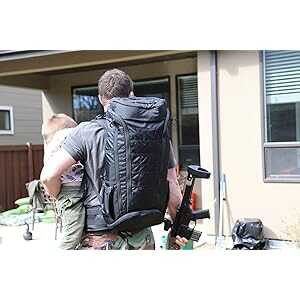
Clay, 2 moa with irons over a backpack is pretty good man.
You cracked me up when you called the side gate a new thing. But I guess if you’re talking just Henry, it’s approximately accurate.
I have a 336 and a 39 Mountie, but my favorite is my Rossi 92 16″ .357. I deleted the safety, swapped out the plastic follower and the hammer spring, added a Skinner peep sight, and slicked up the action per Steve’s Gunz’s DVD. I call it my hillbilly laser!
I really would like to know more about how it would be possible to do anything to brass that would make it as strong as steel. It just doesn’t seem there is any way that a version of the trusty old alloy of copper and zinc could ever make that claim.
“I really would like to know more about how it would be possible to do anything to brass that would make it as strong as steel. It just doesn’t seem there is any way that a version of the trusty old alloy of copper and zinc could ever make that claim.”
Saw a common mild steel bar with a brand new hack saw blade, then go at a chunk of quality brass with same blade, and back again to the steel. Read most any craft man material about not using your quality hand files interchangeably on brass and steel. Hand drill both with same size new bit each. Run through them with a tap!
It’s not about the copper and zinc alone, a mere ‘trusty old alloy’. Machine grade brass denotes specific alloys, combined to create specific qualities. There is no issue what so ever using modern metallurgy on medium pressure smokeless cartridges. The historical black powder cartridges in brass receivers and pistol frames were comparatively anemic.
The lever action has a lot going for it as a tactical rifle if you live in a jurisdiction which prevents you from owning a semi-auto AR or using detachable magazines. A practiced lever action shooter can throw out a blizzard of lead with practice. The side gate allows you to top off your tubular mag while leaving a round in the chamber and ready for use (just like a pump or semi-auto shotgun). For this reason, I have been cold towards Henry rifles because they used the old method (circa mid 1800’s) of loading a tubular magazine from the muzzle end. That makes it a non-starter as a tactical rifle for me – YMMV. However, recently Henry has been adding side gate loading to many of its models and that is a welcome upgrade to me. I would readily consider any Henry model with the side gate feature.
Elmer Keith always wrote about his 1886 Winchester 45-70’s. He shot just about every big game critter on the North American Continent! His pet load was 53 hrs of IMR 3031 and a Speer 400 grain flat point. This my favorite hunting load too. Have taken a lot of big game with this load in my 1895 Marlin and my 1886 Winchester. Just wonder how the brass frame Henry will hold up to this load? You can shoot the “powder-puff” factory loads all day as they are loaded so they can be shot in a Trapdoor 1873 Springfield. Try a couple hundred Elmer Keith loads and see how well the new brass frame Henry holds up!!
Big Daddy Clay: you did a nice presentation of Henry’s 45-70 lever gun. The Model 1886 Winchester is still the Cadillac 45-70 lever gun of all time. The Marlin 1895 is my modern pick of 45-70’s. Can’t believe.the brass frame will stand the test of time. I’ve restored and repaired several Winchester 1866’s over my gunsmithing career. The brass frames do not hold up!! They wear out! Period!
Their probably made with a high strength bronze alloy like aluminum bronze or beryllium bronze which either one is stronger than some steels and wear like diamond.
Certainly a nice firearm, shiny brass fittings always sell well, however some credit should go to John Marlin for the original design. This rifle is essentially a brass clone of a 336 Marlin but with an opening tube magazine. Also if you compare any early 20th century Marlin to this rifle, right away you will notice what we’ve lost in manufacturing with labor costs climbing as they have. Older rifles had much more finish to them such as fairing and rounding of the the lever, trigger, and hammer which could be accomplished by hand with wages of the period. Henry rifles certainly don’t have diminished function as a result of diminished hand fitting, but when placed side by side with a vintage firearm the difference is quite apparent.
Modern machining tools have made it possible to replace some of the expensive hand labor, such as with the new Colt Python. Colt had to discontinue making them in the 70’s primarily due to the labor costs of hand fitting. With new machining no fitting is necessary and they are again in production. I believe this is also the case with Henry. Those steel parts that were hand contoured and fitted are now made without that requirement giving us a firearm that we can afford, but not quite as pretty as the old rifles.
I love everything about this rifle….
Love my 45-70 but getting ammunition is absolutely impossible so it sits in the back of the gun vault as a paperweight
Loading and shooting 45-70’s is easy and cheap! A Lee bullet mound and wheel weights some
4227 powder and a reloading press with a three die set will get you shooten that lever gun! I have two hungry Gatling. One is a new 5-barrel Colt Bulldog the other is a 10 barrel 1884. My Dillon 1050 Super cranks about 500 rounds per hour. A Magma Master Caster turns out the bullets !! 45-70 lever guns are not expensive to load for!!
A single stage loader is more than adequate for big bore repeaters; especially compared to $3000+ of mechanization; before factoring powder, lead, primers and cartridge cases…consuming those resources nearly at rate equal to modern centerfire cartridges.
Now, granted that comment was submitted Pearl harbor day of 2020, things a wee bit different currently.
I might prefer a farmhouse behind the door 30-30 from a gun show to the pretty Henry as a tactical rifle. A 44 Mag would also work.
FYI – I checked with Hornady because about the differences between their Critical Defense (CD) rounds and the LeveRevolution are essentially the same round. I can use the CD ammo in tube magazines so if you have a .357Mag or .44Mag lever gun you can use Hornady’s CD ammo in your pistol caliber rifle. That is a very good thing from Hornady.
It; hard to beat a lever action for a fun day of shooting. I have 4 a Winchester mod 94, 8 shot 30-30 I bought for $80.00 when I was a kid and my dad left me his Winchester mod 94, 30-30. I have a 35 Cal I love shooting the .35 it’s an old Marlin. I have a Marlin 45-70 that shoots great. I grow up using lever actions and open sights I don’t know if I could use a scoop, had a lot of good times out in the mountains using the lever-action and shooting flat nose bullets they did an excellent job in getting game, I do say that Hornady new bullet is great and does an excellent job.
They need to add a picninny rail on top for a red dot or scope!
Mag fed levers would nit gave the limitation on ammo, either.
That’s what the 4 plug screws on top of the receiver are for. I think E Arthur Brown sells them. Same spacing as a Marlin.
1866 Tactical?!! Wow this Dude knows nothing about old west firearms. The 1866 Winchester was made in .44 rimfire not .45-70! What a joke!
Thanks for the info professor, you need to read the article again to get the concept of the meaning and feeling.
As true with sports statisticians, well, clearly there exists different levels of firearm historians; desk seat, arm chair, sofa, recliner, chaise lounge, and those under a beach umbrella.
There also isn’t evident wholesale crossbreeding with English majors, either in technical or illustrative composition.
MSM and the left are common habitat for those creatures.
IYKWIM
LGB
FJB
I have the Henry Big Boy, .44 mag/.44 special. I just love it but reluctant to take it hog hunting as was the original plan. It’s so damn pretty! I know it’s meant to be shot, but falling off a swamp buggy or banging it around? I have other capable rifles I don’t mind putting some dings in if I have to. I added a rubber recoil pad to the stock. Not because of recoil (not bad at all) but the brass butt plate is very slippery.
I prefer the octagon barrel. Would like to try out the side load. Henry has always made a beautiful weapon. One day I’ll be able to afford one.
I agree–I have the 22″ octagon barreled version. It balances great and that extra 2″ does make a difference in lobbing those big bullets further, not to mention a better sight radius when using just the irons.
I’d like a new catalog Please send me one. My address is 79 Saratoga Road, Glenville, New York, 12302-4112
Great Video. Henry Rifles are A True American Master piece of Our History. Also in 45/70 . 147 Year Old Cartridge.
Great Job. Thanks Carl Lucci
I’m writing a short distance away from the building where BJ Henry first developed his Henry rifle in Windsor, VT. The Golden Boy rifle that hangs in that museum building looks a lot like this new model because of the brass receiver.
I love my Marlin 1895 45-70. After 6 shoulder surgeries, I just don’t shoot it much anymore. Maybe if I reloaded rounds for it like a sane person it would help? I need to load some 45-70 Gov’t. equivalent rounds and see how that goes. I did buy a Henry Big Boy in 327 Federal Magnum, and absolutely love it. It have the “Brass” receiver as well, so it’s beautiful as well as functional. It shoots .32 H&R Magnum as well, feeding both without a hitch. The “secret” for those new to Lever Actions is to work that lever like you’re mad at it. I highly recommend Henry Rifles.
Like their guns a lot. Good to see a caliber I like. They need to offer a BIG Loop lever for their rifles. The brass is beautiful when it’s new, but scratches easily because it’s soft.
Regarding big loops, I was fortunate to find and purchase a new Henry Big Boy Color Case Hardened .45 Long Colt this past summer with a 16″ barrel and big loop lever – shades of Chuck Connors – 7+1 brass tube magazine – blued octagon barrel and not “shiny” if you decide to take it into the woods or want to stay fairly undetected visually.
My gun smith/FFL wanted to know if I wanted to sell it when it came in – not for any money because they are just not available anywhere.
I have a Taurus Judge Public Defender revolver that takes .45LC and .410 shot shells. I have plenty of Hornady CD in .45LC to feed.
Well John, Henry does make and sell their rifles with the big loop levers. They also sell the blued and stainless steel big loop versions for their rifles on their Henry parts page. Go to their webpage here, https://henrypride.com/collections/rifle-parts
As always good info and review-were you at 100 yds at when you shot prone 2” group. I e got one if those Eberlestock shooting pads, they’re worth every penny – smoked a black bear at 348 yards off a tree stump by placing that pad on the stump to shoot up hill and across a draw
WERE TO BUY 45 70 HENRY
Shop on GunsAmerica!
I have the 45/70 in the Marlin brand. Love th gun, easy to shoot and faster than a bolt action. Nor really useful for hunting over 200 yards. Have had good luck with the Hornady 300 grain ammo.
It’s a personal preference, I know, but the checkering is overdone. I’d prefer something a little less ostentatious. It reminds me of the giant billboards that used to adorn the slide on some 1911s.
$10450.00 I spend that rebuilding or restoring old single shot rifles. This might be the 1 modern rifle I buy. I would have to let the brass age some. I do prefer caseharding to brass.
I just read the .22 statements. But I’ve had a Marlin 39A for years now, and what a reliable shooter and it’s a takedown so it’s easy to take places. There’s nothing like wood and steel!! I respect the polymer, but they just don’t have the sentimental value that the older versions have, maybe in the future, but for me not yet! Joe
One of the benefits of having the side load and magazine load is that in unloading, one need not cycle all the rounds through the action, rather, just remove the magazine tube and slide all the remaining rounds out of the magazine. A great safety feature and could reduce the risk of an accidental discharge while unloading, kudos to Henry.
I like Henry, But I’ve got 5 original Winchesters, 3 73’s (2 in 44-40, 1in 38-40) and they only hate Hornady? All the other makers are ok, go figure? My 94’s will take any body but sometimes Hornady will be a problem, but no where near the rejection the 73’s do! My 94’s are 38-55 and 30-30 made in 1949, they are beautiful to shoot, but I sure admire the Henry’s. If I ever want another lever action, Henry is the only way to go. Joe
I have a Marlin 45-70 Guide Gun . . . love shooting it (and all lever actions) and I agree that the Hornady ammo is by far the best out there. I will have to check this gun out – as I have a .22 cal Henry . . . they make really nice stuff!
I like the Hornadys, but my current favorite is a Barnes 300 grain tsx.
the world was a better place when everyone including you and your neighbors kids had one of these
Another “gotta get ” Henry for me
I was scrolling to the bottom looking for a $2,000+ price tag. But at an MSRP of $1045.00, it is going on the wish list.
I have the 22″ octagonal barreled tube-fed 45-70 Brass Big Boy, that extra barrel length makes a difference on delivering that wallop further out, the rifle you review looks like a kowtow to the trapper crowd while incorporating the “massive demand” for a side gate loader (which I personally can live without, I have many lever guns of both styles). I wonder why they still put the tube feed option on along with the side gate, I’d just make it one or the other since the purchasers are likely going to be significantly biased if they want a side gate IMO. This model leans just a bit on the “gosh she’s a Purdy one” too far for me to go bashing around in the woods with it, but it’s nice to see that it too preserves the brass buttplate ensuring the masochist self-flagellation crowd will remain happy. 45-70, like the 458 socom which it shares many of the same bullets with, is one of the few calibers that I can shoot a one-hole group with and still measure over MOA. LOL
Clay didn’t wear eye protection when he shot the first few rounds. Setting a very bad example!
Love the gun.
I think they may have left the tube loading so you can dump out the cartridges instead of having to jack all the unused ones through the chamber.
So I’ve been told. Doesn’t bother me one way or the other, but I’d still opt for my brass big boy over this. ; )
If they make one in 444cal it would be in my safe nice gun
They do, just not the side gate. $972.00 MSRP
Oops ! My bad, read it wrong !